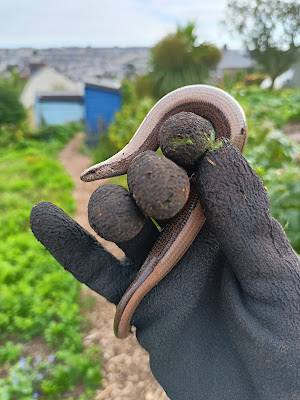Slow Worm!
 Yesterday, on our allotment plot, I worked on completing the rather mundane task of topping up our access paths with woodchips. The Council's tree surgeons very kindly dump piles of the stuff at the top of the site, so my job involved hauling endless wheelbarrow loads back and forth. Good exercise.
Yesterday, on our allotment plot, I worked on completing the rather mundane task of topping up our access paths with woodchips. The Council's tree surgeons very kindly dump piles of the stuff at the top of the site, so my job involved hauling endless wheelbarrow loads back and forth. Good exercise.
While filling my barrow yet again, my heart suddenly skipped a beat when I uncovered the beauty pictured above, not out of fear but elation and wonder.
A slow worm! Although alone, this burst from my lips all the same.
I haven't seen a slow worm in years. Interestingly, their Latin name of Anguis fragilis translates as 'fragile snake', but they aren't actually snakes (or worms) at all. Misnomers all over the place!
Instead, they are legless lizards. Unlike snakes, and like lizards, slow worms have eyelids. This gives them the ability to close their eyes, which snakes simply can't do. A slow worm can also shed its tail when attacked to provide the predator a distracting tasty morsel giving the slow worm time to escape.
The wonders of slow worms don't stop there. Even more bizarrely, they give birth to live young rather than laying eggs, due to being ovoviviparous. This means the female retains her eggs rather than laying them. The eggs hatch inside her body and she then gives birth to her young, up to 12, which I find astonishing.
I'm suspicious that the beautiful lady I found was, in fact, pregnant. If you take a look at the photo above again, you'll notice as I did that her belly does look decidedly swollen. It is the right time of year for slow worms to give birth too. They usually do so in late August into September.
The reason I got so excited finding one is because they are a species included on the UK's Biodiversity Action Plan Priority List. It is a shame the BAP list needs to exist. It contains all the species considered most threatened in this country and, as such, requiring conservation action.
Very special indeed. Now that I know the allotment contains slow worms, I'll set aside a quiet sunny spot on our plot by the compost bin, covered by a dark board. Hopefully, this will attract them as a warm safe hide-away, while we'll enjoy lifting the lid to check on their progress when curiosity calls. Ah yes, I can't wait.



Fantastic photo. Does the allotment have hedgehogs? I know hedgehogs and slow worms often go hand-in-hand.
ReplyDeleteSuch a good question! I wish I knew the answer. Let's put it this way, I always keep my eyes open for a spiky ball. Maybe one day.
Delete